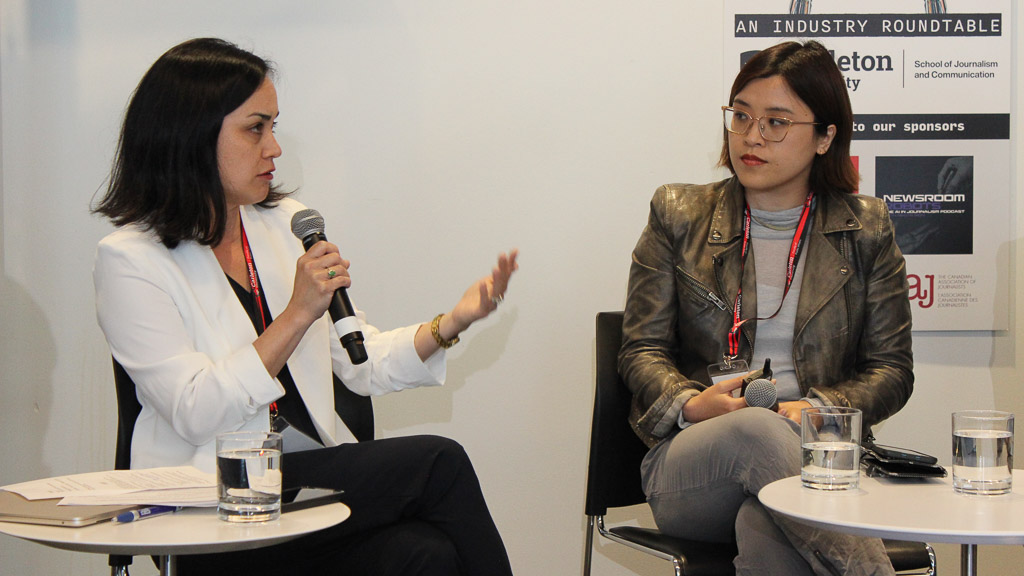A group of experts with diverse touchpoints in the media industry agreed during a roundtable talk on Thursday in Toronto that the use of artificial intelligence in newsrooms might help alleviate the current crisis facing journalism.
Panelists discussed a variety of current and future applications of generative AI, including its use to create summaries of public meetings, to help independent news outlets save time with business development and to generate multiple versions of stories to serve different audiences.

A panel on AI in newsrooms hosted by Carleton University’s School of Journalism and Communication was held May 30 at the downtown Toronto offices of the Globe and Mail. From left to right: Moderator Kate Porter, a CBC broadcaster and Carleton journalism instructor; U.S. media consultant Louise Story, a former Wall Street Journal chief news strategist and chief product & technology officer (on screen); Toronto-based media consultant and entrepreneur Anita Li, founder of The Green Line; Nafid Ahmed, the Globe’s vice-president of enterprise analytics, data science & consumer insights; and Troy Thibodeaux, New Orleans-based director of AI products and services for The Associated Press. [Photo © Angel Xing]
The panel was moderated by Kate Porter, a Carleton journalism instructor and veteran city hall reporter with CBC Ottawa who teaches courses on audio and video journalism and civic institutions.
Troy Thibodeaux, director of AI products and services at The Associated Press, emphasized a pragmatic approach to the technology and the need for a balance between creative experimentation with AI and maintaining rigorous journalistic standards.
U.S.-based AP has been a leader in developing AI solutions for local news outlets, which the news agency has begun experimenting with in-house, said Thibodeaux.
‘Fundamentally, how people consume news, how we produce news, how news gets to people, everything might change in the next five-plus years. So we have to be really fluid in what we’re trying to do.’
— Nafid Ahmed, vice-president of enterprise analytics, data science & consumer insights, Globe and Mail
News organizations “should start someplace where there is a significant enough pain point that people are willing to take a chance,” said Thibodeaux.
The conversation also featured Louise Story, who joined remotely. She is a media consultant at the intersection of journalism and tech who previously worked as chief news strategist and chief product and technology officer at The Wall Street Journal and co-authored The New York Times’ landmark Innovation Report in 2014.
In the face of AI innovation, Story stressed that if journalists can remember that both their economic value and responsibility to the public are fundamentally about creating new information, the news industry may be able to repair the public’s trust by leveraging AI to free up journalists from mundane tasks so they can spend more time observing and investigating for the kinds of stories only perceptive, creative human beings could produce.
“We are currently in a news crisis around the world, because we don’t have as many reporters in the field in front of people. You don’t see reporters out at an event, people don’t meet reporters,” Story said. “And so, this is a moment in our industry where it’s possible, by really effectively using AI, to also get people going out in person.”

Moderator Kate Porter and panelist Anita Li discuss the power of AI in newsrooms. [Photo © Angel Xing]
Anita Li, the founder, editor-in-chief and publisher at The Green Line, a hyper-local Toronto-based news outlet, said utilizing AI tools in her team’s small operation has freed up journalists to have face-to-face connections with the public in Toronto’s “news donuts” — underserved pockets of the city in the media landscape.
“To me, (AI) can really be a boon for local media and maybe generate a renaissance or support the renaissance that’s already flourishing,” she said.
Li said she sees this community-based approach contrasting with the rise of venture capital-backed media outlets during the early 2010s, which have faced deep job cuts and many closures as investors try to wring value out of distressed assets.

Data scientist and Globe and Mail vice-president Nafid Ahmed shares his insights with AP’s AI leader Troy Thibodeaux and the rest of the roundtable attendees on May 30 in Toronto. [Photo © Angel Xing]
Panelist Nafid Ahmed, a data scientist and vice-president of enterprise analytics, data science, and consumer insights at The Globe and Mail, said the current era can be characterized as an “efficiency phase” of AI applications in news. Ahmed said a “transformation phase” will follow in the next two to five years, supported by the foundation of generative AI.
After that, he said, the industry will enter a “new information” phase, during which the entire news distribution model may change completely.
“Fundamentally, how people consume news, how we produce news, how news gets to people, everything might change in the next five-plus years,” Ahmed said. “So, we have to be really fluid in what we’re trying to do,” he said.